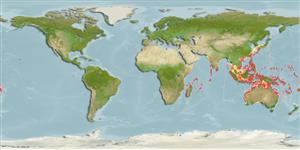Actinopterygii (ray-finned fishes) >
Perciformes (Perch-likes) >
Labridae (Wrasses) > Bodianinae
Etymology: Choerodon: Greek, choiros = a pig + Greek, odous = teeth (Ref. 45335).
Environment / Climate / Range
Ecology
Marine; reef-associated; depth range 10 - 60 m (Ref. 9710), usually 10 - 20 m (Ref. 2334). Tropical, preferred ?
Indo-West Pacific: Ryukyu Islands south to Australia and Indonesia. Reported from Mauritius (Ref. 5503).
Length at first maturity / Size / Weight / Age
Maturity: Lm ?, range 24 - ? cm
Max length : 100.0 cm TL male/unsexed; (Ref. 2272); max. published weight: 15.5 kg (Ref. 2334)
Dorsal
spines
(total): 13;
Dorsal
soft rays
(total): 7;
Anal
spines: 3;
Anal
soft rays: 10. Large adults appear blue underwater and usually have a small black spot at the dorsal fin base. Juveniles have a large white saddle spot following the black spot (Ref. 48636). A moderately small but prominent dark spot present on body at base of last dorsal-fin spine (spot not extending onto fin membrane). Body scales each with a blue centre in life forming horizontal rows of spots on side. Second prominent anterior canine in lower jaw distinctly shorter than first in adults, directed mostly dorsally and slightly anteriorly. 3 to 5 scales on subopercle. (Ref 9823)
Inhabit flat sandy or weedy areas near lagoon and seaward reefs (Ref. 9710). Solitary. Feed mainly on hard-shelled prey including crustaceans, mollusks and sea urchins. Marketed mostly fresh. In Hong Kong live fish markets (Ref. 27253).
Oviparous, distinct pairing during breeding (Ref. 205).
Randall, J.E., G.R. Allen and R.C. Steene, 1990. Fishes of the Great Barrier Reef and Coral Sea. University of Hawaii Press, Honolulu, Hawaii. 506 p. (Ref. 2334)
IUCN Red List Status (Ref. 115185)
CITES (Ref. 94142)
Not Evaluated
Threat to humans
Harmless
Human uses
Fisheries: commercial; aquaculture: commercial; gamefish: yes; aquarium: commercial
More information
ReferencesAquacultureAquaculture profileStrainsGeneticsAllele frequenciesHeritabilityDiseasesProcessingMass conversion
Tools
Special reports
Download XML
Internet sources
